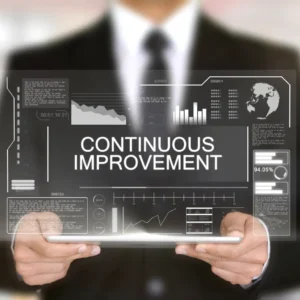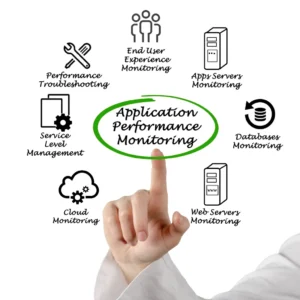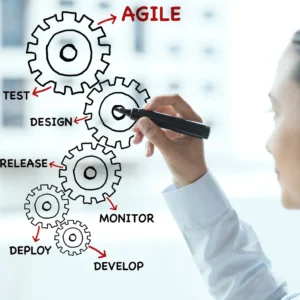
Decoding Excellence
Navigating the Complexities of Intelligent Process Automation Vendor Selection
In the dynamic landscape of Intelligent Process Automation (IPA), selecting the right vendor is a pivotal step that can shape the success of automation initiatives.
This article delves into the intricacies of “Vendor Selection in Intelligent Process Automation (IPA),” navigating through critical considerations that organizations must weigh to make informed decisions. From technological capabilities and scalability to legal considerations and user experience, the comprehensive exploration of these aspects is vital for establishing a robust foundation.
The strategic framework outlined herein encompasses diverse criteria, adaptive protocols, ethical governance, and user-centric design principles.
In a world where automation and human oversight must harmonize seamlessly, this article provides actionable insights into evaluating vendors’ offerings, ensuring alignment with business goals, and fostering a trustworthy partnership for the sustainable implementation of Intelligent Process Automation.
Vendor Evaluation Criteria
Strategic Framework for Vendor Evaluation Criteria in Intelligent Process Automation (IPA) Selection
Choosing the right vendor is crucial for successful automation initiatives. This is especially true in the rapidly changing world of Intelligent Process Automation (IPA). Organizations require a well-defined and strategic framework for evaluating potential vendors to meet their immediate automation needs and prepare for future advancements. This article explores the most critical aspects of vendor selection in IPA, presenting a comprehensive and strategic framework for assessing vendors.
Comprehensive Criteria for Assessing Vendor Capabilities, Experience, and Expertise
An effective vendor selection process begins with thoroughly understanding the vendor’s capabilities, experience, and expertise. Organizations should prioritize criteria such as the vendor’s track record in delivering successful IPA solutions, industry-specific knowledge, and the depth of their technical expertise. Evaluating past performance and client testimonials can provide valuable insights into the vendor’s ability to meet specific business requirements.
Protocols for Evaluating Technological Proficiency and Innovation in IPA Solution Providers
Technological proficiency and innovation are critical components in the realm of IPA. Organizations should establish protocols for evaluating a vendor’s technological capabilities, ensuring they are up-to-date with the latest advancements in automation technologies. Assessing a vendor’s commitment to research and development, investment in emerging technologies, and innovation ability will be integral in selecting a partner to drive continuous improvement.
Balancing Automation and Human Oversight through Rigorous Evaluation of Vendor Offerings
It is crucial to balance automation and human oversight to implement IPA successfully. A robust vendor evaluation process should include criteria that assess a vendor’s understanding of this delicate equilibrium. This involves evaluating the vendor’s approach to integrating automation seamlessly into existing workflows and their strategies for incorporating human oversight to ensure accuracy, compliance, and adaptability.
Dynamic Criteria for Adapting to Changing Business Needs and Technological Advancements
The dynamic nature of business environments and technological advancements necessitates an adaptable vendor selection framework. Organizations should establish dynamic criteria that can evolve alongside changing business needs and emerging technologies. This involves assessing a vendor’s ability to adapt, scale, and remain current with technological advancements to safeguard automation investments.
Governance Frameworks for Ethical and Transparent Implementation of Vendor Evaluation Criteria in IPA
Given the potential impact on employees and stakeholders, ethical considerations are paramount in vendor selection for IPA. Establishing governance frameworks ensures a transparent and ethical evaluation process. This includes assessing vendors for compliance with ethical standards, data privacy regulations, and transparency in their automation processes.
Proactive Measures for Aligning Vendor Capabilities with Specific Business Requirements
Organizations should take proactive measures during the vendor evaluation to ensure alignment with specific business requirements. This involves clearly defining their automation goals, communication protocols, and performance expectations. Assessing a vendor’s flexibility and willingness to customize solutions to meet specific business needs is crucial for a successful partnership.
Adaptive Evaluation Protocols Tailored to Varied Automation Scenarios and Business Environments
Automation scenarios and business environments can vary significantly across industries and organizations. Therefore, the evaluation process should be adaptive and tailored to these differences. Organizations should establish protocols that account for their industry’s unique challenges and opportunities, ensuring that selected vendors possess the domain expertise required for successful IPA implementation.
User-Centric Design Principles for Ensuring Vendor Solutions Align with User Needs and Preferences
Having a positive user experience is crucial for successfully implementing any automation process. Organizations should prioritize user-centric design principles when evaluating vendors. This involves assessing the usability, accessibility, and intuitiveness of the vendor’s solutions to ensure that end-users can seamlessly integrate automation into their daily workflows.
Ensuring Compliance with Vendor Evaluation Standards and Best Practices in the Context of IPA Implementation
Finally, to ensure a standardized and efficient evaluation process, organizations should establish compliance with vendor evaluation standards and best practices. This involves benchmarking vendor performance against industry standards, leveraging industry-specific best practices, and incorporating lessons from successful IPA implementations in similar contexts.
A strategic framework of evaluation criteria is crucial for selecting Intelligent Process Automation (IPA) vendors to leverage automation technologies fully. By defining and prioritizing comprehensive criteria, establishing protocols for assessment, and incorporating ethical and adaptive frameworks, organizations can confidently select vendors that align with their business objectives and pave the way for successful IPA implementation.
Technology Compatibility Assessment
Strategic Framework for Technology Compatibility Assessment in Intelligent Process Automation (IPA) Vendor Selection
In the ever-evolving landscape of Intelligent Process Automation (IPA), selecting a vendor whose solutions seamlessly integrate with existing technology infrastructure is paramount for success. This article explores a strategic framework for technology compatibility assessment in IPA vendor selection, emphasizing comprehensive criteria, seamless integration protocols, and governance frameworks to ensure ethical and transparent evaluations.
Comprehensive Criteria for Evaluating Compatibility with Existing Technology Infrastructure
The foundation of a robust technology compatibility assessment lies in a comprehensive set of criteria. Organizations should prioritize evaluating a vendor’s solutions based on their compatibility with existing technology infrastructure. This includes assessing system architecture, data formats, communication protocols, and security standards. A thorough examination of these criteria ensures that the chosen vendor aligns with the organization’s technological ecosystem.
Protocols for Ensuring Seamless Integration of Vendor Solutions with Current Systems
Seamless integration is a crucial determinant of successful IPA implementation. Establishing protocols for evaluating a vendor’s integration capabilities is essential. This involves assessing the ease of integration, compatibility with existing APIs, and the ability to adapt to different integration scenarios. A vendor’s commitment to providing robust integration solutions helps smooth the transition and minimizes disruptions to ongoing operations.
Balancing Automation and Human Oversight through Rigorous Technology Compatibility Analysis
Balancing automation with human oversight requires a nuanced understanding of how technology aligns with organizational processes. A rigorous technology compatibility analysis should include an evaluation of the vendor’s approach to human-machine collaboration. This ensures that automation solutions complement human capabilities, fostering a harmonious working environment and enhancing overall operational efficiency.
Dynamic Assessment for Adapting to Changing Technological Requirements and Business Environments
Technology landscapes are dynamic, and business requirements evolve. A successful technology compatibility assessment framework should be dynamic and capable of adapting to changing technological needs and business environments. This involves regularly updating evaluation criteria to align with emerging technologies, industry standards, and organizational goals, ensuring a future-proofed automation solution.
Governance Frameworks for Ethical and Transparent Implementation of Technology Compatibility Assessment in IPA
Ethical considerations are pivotal in the evaluation process. Establishing governance frameworks guarantees an ethical and transparent technology compatibility assessment. This includes evaluating vendors for compliance with data privacy regulations, ethical AI practices, and transparent disclosure of their technology’s impact on existing systems and processes.
Proactive Measures for Minimizing Disruption and Maximizing Synergy with Current Technology Stack
Organizations should adopt proactive measures during the technology compatibility assessment to minimize disruption and maximize synergy. This involves conducting impact analyses, assessing potential friction points, and implementing risk mitigation strategies. A proactive approach ensures a seamless integration process that enhances, rather than disrupts, the existing technology stack.
Adaptive Compatibility Assessment Protocols Tailored to Varied Automation Scenarios
Automation scenarios can vary widely across industries and organizations. Therefore, compatibility assessment protocols should be adaptive and tailored to these differences. Organizations should develop criteria that consider the unique requirements of their automation scenarios, ensuring the selected vendor can provide solutions tailored to their specific needs.
User-Centric Design Principles for Ensuring Technological Solutions Align with User Experience Goals
User experience is integral to the success of any technological solution. The technology compatibility assessment should incorporate user-centric design principles to ensure the chosen vendor’s solutions align with user experience goals. This involves evaluating the user interface, accessibility, and overall user-friendliness of the automation tools.
Ensuring Compliance with Technology Compatibility Assessment Standards and Best Practices in the Context of IPA Implementation
Organizations must ensure compliance with technology compatibility assessment standards and best practices to maintain a standardized and efficient assessment process. Benchmarking against industry standards, adopting recognized assessment methodologies, and incorporating lessons learned from successful IPA implementations contribute to a reliable and effective evaluation process.
In conclusion, a strategic framework for technology compatibility assessment in IPA vendor selection is crucial for organizations seeking successful automation integration. By incorporating comprehensive criteria, seamless integration protocols, and ethical governance frameworks, organizations can confidently choose a vendor whose solutions align seamlessly with their existing technology infrastructure, fostering a harmonious and efficient automation ecosystem.
Scalability and Flexibility Assessment
Strategic Framework for Scalability and Flexibility Assessment in Intelligent Process Automation (IPA) Vendor Selection
In the realm of Intelligent Process Automation (IPA), selecting a vendor with scalable and flexible solutions is paramount to accommodate the dynamic nature of business environments. This article explores a strategic framework for scalability and flexibility assessment in IPA vendor selection, outlining comprehensive criteria, adaptable protocols, and ethical governance frameworks to ensure a future-proofed automation investment.
Comprehensive Criteria for Evaluating the Scalability of Vendor Solutions to Accommodate Future Business Growth
A robust scalability assessment begins with comprehensive criteria that evaluate a vendor’s ability to accommodate future business growth. Organizations should scrutinize factors such as system performance under increased loads, the scalability of automation processes, and the vendor’s track record in supporting clients through periods of rapid expansion. Evaluating scalability ensures that the selected IPA solution can seamlessly grow alongside the organization.
Protocols for Ensuring the Flexibility of IPA Solutions to Adapt to Changing Business Needs
Flexibility is critical in an environment where business needs are in constant flux. Establishing protocols for evaluating a vendor’s flexibility involves assessing their capacity to adapt to changing requirements, workflows, and technological advancements. A flexible IPA solution should integrate smoothly into existing processes and allow for agile adjustments to meet evolving business needs.
Balancing Automation and Human Oversight through Rigorous Scalability and Flexibility Analysis
Achieving the right balance between automation and human oversight requires a rigorous analysis of scalability and flexibility. Organizations should assess how well a vendor’s solutions strike this balance, ensuring that as automation scales, there are mechanisms for incorporating necessary human intervention, maintaining compliance, and adapting to nuanced scenarios that may require human judgment.
Dynamic Assessment for Adapting to Evolving Requirements and Technological Advancements
A dynamic assessment approach is crucial to adapt to evolving requirements and technological advancements. Organizations should continually update evaluation criteria to align with emerging technologies, industry standards, and the organization’s changing needs. This dynamic approach ensures that the chosen vendor can evolve alongside the fast-paced advancements in the IPA landscape.
Governance Frameworks for Ethical and Transparent Implementation of Scalability and Flexibility Criteria in IPA
Ethical considerations are central to scalability and flexibility assessments. Implementing governance frameworks ensures an ethical and transparent evaluation process. This includes evaluating vendors for ethical AI practices, transparency in handling scalability challenges, and ensuring that flexibility does not compromise ethical standards or data privacy.
Proactive Measures for Future-Proofing Automation Investments Through Scalability and Flexibility
Organizations must adopt proactive measures during scalability and flexibility assessments to future-proof automation investments. To maintain a seamless business operation, it’s crucial to clearly understand potential barriers to growth, proactively plan for future requirements, and ensure that your vendors can adapt to new challenges. This involves careful planning and proactive measures to address potential issues before they occur.
Adaptive Assessment Protocols Tailored to Varied Automation Scenarios and Business Environments
Automation scenarios and business environments can vary widely. Therefore, assessment protocols should be adaptive and tailored to these differences. Criteria for scalability and flexibility assessments should consider specific industries’ unique challenges and opportunities, ensuring that the selected vendor can adapt their solutions to varied automation scenarios.
User-Centric Design Principles for Ensuring Scalable and Flexible Solutions Align with User Experience Goals
The user experience is pivotal to the success of any scalable and flexible solution. Organizations should prioritize user-centric design principles when evaluating vendors. This involves assessing how well the scalability and flexibility features align with user experience goals, ensuring that end-users can seamlessly integrate and adapt to changes introduced by the IPA solutions.
Ensuring Compliance with Scalability and Flexibility Standards and Best Practices in the Context of IPA Implementation
Maintaining compliance with scalability and flexibility standards and best practices is essential for a standardized and efficient evaluation process. Benchmarking against industry standards, adopting recognized methodologies, and learning from successful IPA implementations ensure that the selected vendor adheres to best practices in scalability and flexibility.
In conclusion, a strategic framework for scalability and flexibility assessment in IPA vendor selection is indispensable for organizations aiming to future-proof their automation investments. By incorporating comprehensive criteria, adaptable protocols, and ethical governance frameworks, organizations can confidently select vendors whose solutions can seamlessly scale and adapt to meet the dynamic requirements of evolving business landscapes.
Total Cost of Ownership (TCO) Analysis
Strategic Framework for Total Cost of Ownership (TCO) Analysis in Intelligent Process Automation (IPA) Vendor Selection
To ensure an effective implementation of Intelligent Process Automation (IPA), conducting a comprehensive Total Cost of Ownership (TCO) analysis is crucial when selecting a vendor. This article explores a strategic framework for TCO analysis in IPA vendor selection, encompassing comprehensive criteria, evaluation protocols, and ethical governance frameworks to ensure transparency, budget alignment, and optimal financial decision-making.
Comprehensive Criteria for Conducting a Holistic TCO Analysis for IPA Solutions
A holistic TCO analysis requires a comprehensive set of criteria beyond initial costs. Organizations should evaluate not only upfront expenses but also consider ongoing costs throughout the entire lifecycle of the IPA solution. Criteria should include licensing fees, maintenance costs, training expenses, scalability costs, and potential costs associated with system upgrades and integrations.
Protocols for Evaluating Both Upfront and Ongoing Costs Associated with Vendor Implementations
Effective TCO analysis protocols should meticulously evaluate upfront and ongoing costs associated with vendor implementations. Upfront costs may include licensing fees, initial customization, and implementation expenses. Ongoing costs involve maintenance, support, training, scalability, and any potential hidden costs that may emerge as the automation solution evolves.
Balancing Automation and Human Oversight through Rigorous TCO Assessment Strategies
Balancing automation with human oversight necessitates a rigorous TCO assessment strategy. Organizations should assess how the TCO aligns with the level of human intervention required to maintain and optimize the automation solution. This ensures that the selected vendor provides a cost-effective solution without compromising on the necessary human oversight for compliance, adaptability, and quality control.
Dynamic TCO Analysis for Adapting to Changing Business Needs and Cost Structures
Business needs and cost structures are dynamic, requiring a TCO analysis that can adapt accordingly. A dynamic TCO analysis should consider changing business requirements, technological advancements, and shifts in the cost landscape. This ensures that the TCO remains aligned with evolving organizational goals and adapts to the dynamic nature of the IPA environment.
Governance Frameworks for Ethical and Transparent Implementation of TCO Analysis in IPA
Ethics and transparency are integral components of TCO analysis. Establishing governance frameworks ensures an ethical and transparent TCO evaluation process. This involves disclosing all relevant costs, avoiding hidden fees, and ensuring that the TCO analysis aligns with ethical business practices and industry standards.
Proactive Measures for Identifying Hidden Costs and Ensuring Budget Alignment in Automation Initiatives
Proactively identifying hidden costs is crucial for budget alignment in automation initiatives. Organizations should implement measures such as thorough vendor communication, detailed contractual agreements, and regular reviews to identify and mitigate potential hidden costs. This proactive approach ensures that the TCO analysis remains aligned with budgetary constraints and overall financial goals.
Adaptive TCO Assessment Protocols Tailored to Varied Automation Scenarios and Business Environments
Automation scenarios and business environments differ across industries, requiring adaptive TCO assessment protocols. Criteria for TCO analysis should be tailored to specific automation scenarios, accounting for variations in industry needs, regulatory requirements, and the unique challenges posed by varied business environments.
User-Centric Design Principles for Ensuring TCO Alignment with User Experience Goals
When analyzing the total cost of ownership (TCO), it is essential to consider the goals related to user experience. It’s best to organize the text logically by putting the most critical information first and using short sentences with only the necessary details to achieve clarity and coherence. Organizations should prioritize user-centric design principles when evaluating TCO. This involves considering the costs associated with user training, system usability, and potential workflow disruptions. Aligning TCO with user experience goals ensures a smooth integration and user acceptance of the IPA solution.
Ensuring Compliance with TCO Analysis Standards and Best Practices in the Context of IPA Implementation
Maintaining compliance with TCO analysis standards and best practices is essential for a standardized and efficient evaluation process. Organizations should benchmark their TCO analysis against industry standards, adopt recognized methodologies, and incorporate lessons from successful IPA implementations to ensure optimal compliance.
In conclusion, a strategic framework for TCO analysis in IPA vendor selection is indispensable for organizations seeking a transparent and cost-effective automation solution. Organizations can confidently select vendors whose TCO aligns with budgetary constraints by incorporating comprehensive criteria, rigorous evaluation protocols, and ethical governance frameworks, ensuring a financially sound and successful IPA implementation.
Vendor Reputation and Reliability Assessment
Strategic Framework for Vendor Reputation and Reliability Assessment in Intelligent Process Automation (IPA) Vendor Selection
In the complex landscape of Intelligent Process Automation (IPA), selecting a vendor with a stellar reputation and unwavering reliability is paramount to the success of automation initiatives. This article explores a strategic framework for vendor reputation and reliability assessment in IPA vendor selection, emphasizing comprehensive criteria, evaluation protocols, and ethical governance frameworks to ensure transparency, user trust, and optimal vendor performance.
Comprehensive Criteria for Evaluating the Reputation and Reliability of IPA Solution Providers
A comprehensive evaluation of vendor reputation and reliability begins with criteria that delve into various aspects of a vendor’s standing in the market. Organizations should assess factors such as the vendor’s track record, client testimonials, industry recognition, and overall reliability in delivering IPA solutions. A holistic approach to these criteria ensures a thorough understanding of the vendor’s reputation.
Protocols for Assessing Vendor Stability, Industry Standing, and Market Presence
Vendor assessment protocol should encompass stability, industry standing, and market presence. Organizations should evaluate the financial stability of vendors, their standing within the industry, and their overall presence in the market. This includes analyzing the vendor’s market share, partnerships, and strategic alliances, providing insights into their long-term viability and commitment to the IPA landscape.
Balancing Automation and Human Oversight through Rigorous Evaluation of Vendor Reputation
Balancing automation with human oversight requires a rigorous evaluation of vendor reputation. Organizations should assess how well a vendor aligns with the principles of ethical AI, transparency, and reliability. Rigorous evaluation ensures that the selected vendor is not only technologically proficient but also possesses a reputation for ethical business practices and reliability in delivering solutions that align with organizational goals.
Dynamic Assessment for Adapting to Changing Vendor Landscapes and Market Dynamics
The vendor landscape and market dynamics are subject to change. Therefore, assessment protocols should be dynamic and capable of adapting to evolving vendor scenarios and market dynamics. This involves regularly updating evaluation criteria to align with shifts in the vendor landscape, ensuring that the selected vendor remains at the forefront of industry advancements.
Governance Frameworks for Ethical and Transparent Implementation of Vendor Reputation Assessment in IPA
Ethical considerations are paramount in vendor reputation assessment. Implementing governance frameworks ensures an ethical and transparent evaluation process. This includes evaluating vendors for adherence to ethical AI principles, transparent business practices, and clear communication regarding their reputation and reliability. A governance framework ensures a trustworthy vendor selection process.
Proactive Measures for Verifying Vendor Reliability, Support Capabilities, and Customer Satisfaction
Proactively verifying vendor reliability, support capabilities, and customer satisfaction is critical for a successful IPA implementation. Organizations should implement measures such as direct engagement with existing clients, exploring support mechanisms, and analyzing customer satisfaction surveys. Proactive measures guarantee that the selected vendor is reliable and equipped to provide ongoing support and meet customer expectations.
Adaptive Reputation Assessment Protocols Tailored to Varied Automation Scenarios and Business Environments
Reputation assessment protocols should be adaptive and tailored to the diverse automation scenarios and business environments. Organizations should consider industry-specific challenges, regulatory requirements, and the unique needs of their business environment. Adaptive protocols ensure that the selected vendor’s reputation aligns with the specific demands of varied automation scenarios.
User-centric design Principles for Ensuring Vendor Reputation Aligns with User Trust and Expectations
User trust is a fundamental component of a successful vendor partnership. Therefore, vendor reputation should align with user-centric design principles. Organizations should evaluate how well the vendor’s reputation aligns with user expectations, trust-building practices, and a commitment to delivering solutions prioritizing user experience and satisfaction.
Ensuring Compliance with Vendor Reputation and Reliability Assessment Standards and Best Practices in the Context of IPA Implementation
Maintaining compliance with vendor reputation and reliability assessment standards is essential for a standardized and efficient evaluation process. Organizations should benchmark their assessment against industry standards, adopt recognized methodologies, and incorporate lessons from successful IPA implementations to ensure optimal compliance.
In conclusion, a strategic framework for vendor reputation and reliability assessment in IPA vendor selection is crucial for organizations aiming to build a trustworthy and enduring partnership. By incorporating comprehensive criteria, rigorous evaluation protocols, and ethical governance frameworks, organizations can confidently select vendors whose reputation aligns with their values, ensuring a reliable and successful IPA implementation.
Security and Compliance Measures Assessment
Strategic Framework for Security and Compliance Measures Assessment in Intelligent Process Automation (IPA) Vendor Selection
In the ever-evolving landscape of Intelligent Process Automation (IPA), selecting a vendor with robust security and compliance measures is critical to safeguard sensitive data and ensure adherence to regulatory standards. This article explores a strategic framework for security and compliance measures assessment in IPA vendor selection, outlining comprehensive criteria, evaluation protocols, and ethical governance frameworks to guarantee a secure and compliant automation environment.
Comprehensive Criteria for Evaluating the Security Features of IPA Solutions
A comprehensive evaluation of security features in IPA solutions is fundamental to the vendor selection process. Organizations should assess criteria such as encryption protocols, access controls, authentication mechanisms, and the overall cybersecurity posture of potential vendors. A holistic approach to security criteria ensures the selection of a vendor capable of safeguarding sensitive data and mitigating potential security threats.
Protocols for Ensuring Adherence to Data Protection and Regulatory Standards by Potential Vendors
Adherence to data protection and regulatory standards is non-negotiable in the IPA landscape. Protocols for evaluation should encompass an in-depth analysis of how potential vendors comply with data protection laws, industry-specific regulations, and international standards. This ensures the selected vendor aligns with the organization’s legal obligations and safeguards against potential legal and reputational risks.
Balancing Automation and Human Oversight through Rigorous Security and Compliance Analysis
Organizations should assess how well a vendor’s solution incorporates security features without compromising human-centric oversight. Rigorous analysis ensures that the selected vendor provides seamless automation integration while adhering to the highest security and compliance standards.
Dynamic Assessment for Adapting to Evolving Security Threats and Regulatory Environments
Security threats and regulatory environments are dynamic, necessitating a dynamic assessment approach. Organizations should regularly update evaluation criteria to align with emerging security threats and changes in regulatory frameworks. A dynamic assessment ensures the selected vendor is adaptive and proactive in addressing evolving security challenges and compliance requirements.
Governance Frameworks for Ethical and Transparent Implementation of Security and Compliance Measures in IPA
Ethics and transparency are integral components of security and compliance assessments. Implementing governance frameworks ensures an ethical and transparent evaluation process. This involves evaluating vendors for adherence to ethical AI principles, transparent communication about security practices, and clear disclosure of compliance measures. A governance framework guarantees a trustworthy and transparent vendor selection process.
Proactive Measures for Assessing Vendor Commitment to Robust Security Protocols and Regulatory Compliance
Proactively assessing a vendor’s commitment to robust security protocols and regulatory compliance is essential for risk mitigation. Organizations should perform comprehensive security audits, conduct vendor interviews, and review documentation thoroughly to ensure that potential vendors uphold the highest security and compliance standards.
Adaptive Security and Compliance Assessment Protocols Tailored to Varied Automation Scenarios and Business Environments
Security and compliance assessment protocols should be adaptive and tailored to the diverse automation scenarios and business environments. Organizations should consider industry-specific risks, regulatory variations, and the unique challenges of different business environments. Adaptive protocols ensure that the selected vendor’s security and compliance measures align with the specific demands of varied automation scenarios.
User-centric design Principles for Ensuring Security and Compliance Solutions Align with User Trust and Expectations
User trust is paramount when implementing security and compliance solutions. Therefore, organizations should prioritize user-centric design principles when evaluating vendors. This involves assessing how well the security and compliance measures align with user expectations, ensuring a seamless integration that inspires trust and confidence among end-users.
Ensuring Compliance with Security and Compliance Measures Standards and Best Practices in the Context of IPA Implementation
Maintaining compliance with security and compliance measures standards is crucial for a standardized and efficient evaluation process. Organizations should benchmark their assessment against industry standards, adopt recognized security frameworks, and incorporate lessons from successful IPA implementations to ensure optimal compliance.
In conclusion, a strategic framework for security and compliance measures assessment in IPA vendor selection is indispensable for organizations seeking a secure and compliant automation environment. By incorporating comprehensive criteria, rigorous evaluation protocols, and ethical governance frameworks, organizations can confidently select vendors whose security and compliance measures align with legal obligations, industry standards, and user expectations, ensuring a robust and secure IPA implementation.
Vendor Support and Training Programs Assessment
Strategic Framework for Vendor Support and Training Programs Assessment in Intelligent Process Automation (IPA) Vendor Selection
In the intricate landscape of Intelligent Process Automation (IPA), selecting a vendor with robust support and training programs is pivotal to the success of automation initiatives. This article explores a strategic framework for assessing vendor support and training programs in IPA vendor selection, emphasizing comprehensive criteria, evaluation protocols, and ethical governance frameworks to ensure user proficiency, accessibility, and optimal vendor performance.
Comprehensive Criteria for Evaluating the Quality and Accessibility of Vendor Support Services
A comprehensive evaluation of vendor support services ensures that users receive timely and practical assistance. Criteria should include assessing the responsiveness of support channels, the expertise of support staff, the availability of knowledge bases, and the accessibility of support services. A holistic approach guarantees that the selected vendor provides high-quality, accessible support tailored to user needs.
Protocols for Assessing the Availability and Effectiveness of Vendor Training Programs
Protocols for evaluating vendor training programs should consider availability and effectiveness. Organizations should assess the comprehensiveness of training materials, the accessibility of training resources, the adaptability of training programs to varied user skill levels, and the effectiveness of the training in bridging knowledge gaps. These protocols ensure that users have the necessary skills for successful IPA implementation.
Balancing Automation and Human Oversight through Rigorous Evaluation of Support and Training Programs
Balancing automation with human oversight necessitates a rigorous evaluation of support and training programs. Organizations should assess how well a vendor’s support services and training programs align with the principles of ethical AI, transparency, and the human-centric nature of effective automation. Rigorous evaluation ensures the selected vendor provides seamless automation integration with user support and training.
Dynamic Assessment for Adapting to Evolving User Needs and Skill Requirements
User needs and skill requirements are subject to change. Therefore, assessment protocols should be dynamic and capable of adapting to evolving user scenarios and skill requirements. Regularly updating evaluation criteria ensures that the selected vendor is responsive to changing user needs and adept at tailoring support and training programs to evolving skill requirements.
Governance Frameworks for Ethical and Transparent Implementation of Vendor Support and Training in IPA
Ethics and transparency are integral components of vendor support and training. Implementing governance frameworks ensures an ethical and transparent evaluation process. This involves evaluating vendors for adherence to ethical AI principles, transparent communication about support and training practices, and clear disclosure of the capabilities and limitations of their support services. A governance framework guarantees a trustworthy and transparent vendor selection process.
Proactive Measures for Ensuring Accessible and Responsive Vendor Support Services
Proactive evaluation of vendor support services is essential for user satisfaction. Organizations should implement measures such as direct engagement with vendor support, reviewing customer testimonials, and assessing the vendor’s track record in resolving support issues. Proactive measures ensure that the selected vendor provides accessible and responsive support services aligned with user expectations.
Adaptive Support and Training Assessment Protocols Tailored to Varied Automation Scenarios and Business Environments
Support and training assessment protocols should be adaptive and tailored to diverse automation scenarios and business environments. Organizations should consider industry-specific challenges, regulatory variations, and the unique skill requirements of different business environments. Adaptive protocols ensure that the selected vendor’s support and training programs align with the specific demands of varied automation scenarios.
User-Centric Design Principles for Ensuring Support and Training Programs Align with User Learning Preferences
User learning preferences should be at the forefront of evaluating support and training programs. Organizations should prioritize user-centric design principles, considering factors such as the accessibility of training materials, the availability of multiple learning channels, and the adaptability of training programs to varied learning styles. Aligning programs with user learning preferences ensures effective knowledge transfer and user proficiency.
Ensuring Compliance with Vendor Support and Training Standards and Best Practices in the Context of IPA Implementation
Maintaining compliance with support and training standards is crucial for a standardized and efficient evaluation process. Organizations should benchmark their assessment against industry standards, adopt recognized training methodologies, and incorporate lessons learned from successful IPA implementations to ensure optimal compliance.
In conclusion, a strategic framework for assessing vendor support and training programs in IPA vendor selection is indispensable for organizations aiming to empower users and optimize automation proficiency. By incorporating comprehensive criteria, rigorous evaluation protocols, and ethical governance frameworks, organizations can confidently select vendors whose support and training programs align with user needs, ensuring a successful and user-centric IPA implementation.
Proof of Concept (PoC) Requirements
Strategic Framework for Proof of Concept (PoC) Requirements in Intelligent Process Automation (IPA) Vendor Selection
In Intelligent Process Automation (IPA), conducting a robust Proof of Concept (PoC) is critical in selecting the right vendor. This article explores a strategic framework for PoC requirements in IPA vendor selection, outlining comprehensive criteria, protocols, and ethical governance frameworks to ensure a successful evaluation that aligns with business goals and technical requirements.
Comprehensive Criteria for Defining and Executing a Successful PoC with Potential IPA Vendors
Defining and executing a successful PoC requires a comprehensive set of criteria. Organizations should outline clear objectives, assess the scalability and adaptability of the vendor’s solution, evaluate performance under real-world conditions, and consider the ease of integration with existing systems. A holistic approach ensures that the PoC effectively demonstrates the capabilities and feasibility of the vendor’s IPA solution.
Protocols for Aligning PoC Objectives with Business Goals and Technical Requirements
Aligning PoC objectives with business goals and technical requirements is essential for a meaningful evaluation. Protocols should involve collaboration between stakeholders to clearly define the goals of the PoC, ensuring they align with broader business objectives and technical specifications. This alignment guarantees that the PoC is a relevant and practical demonstration of the vendor’s capabilities.
Balancing Automation and Human Oversight through Rigorous PoC Planning and Execution
Planning and executing a PoC with care is essential and requires finding a balance, which can be delicate. It’s vital to prioritize and present the most critical information straightforwardly and concisely. To ensure clear communication, use simple and familiar words. Avoid acronyms, jargon, and legal terms. It’s best to use verbs instead of nouns and favour the active voice to increase clarity. Organizations should carefully design the PoC scenario to showcase automation capabilities while integrating human oversight where necessary. Thorough planning ensures that the PoC accurately reflects the real-world dynamics of the intended IPA implementation.
Dynamic PoC Requirements for Adapting to Varied Automation Scenarios and Business Environments
PoC requirements should be dynamic to adapt to varied automation scenarios and business environments. Organizations should consider industry-specific challenges, regulatory variations, and the unique needs of different business environments when defining PoC criteria. Customizing the PoC according to the specific requirements is essential to cater to various automation scenarios. This involves incorporating dynamic requirements that capture the unique demands of each use case.
Governance Frameworks for Ethical and Transparent Implementation of PoC Processes in IPA
Ethics and transparency are integral to the PoC process. Implementing governance frameworks ensures an ethical and transparent execution of the PoC. This involves clear communication about the PoC objectives, potential impacts on stakeholders, and adherence to ethical AI principles. A governance framework guarantees a trustworthy and transparent PoC process.
Proactive Measures for Validating Vendor Capabilities in Real-World Scenarios
Proactively validating vendor capabilities in real-world scenarios is crucial for informed decision-making. Organizations should incorporate real-time monitoring, data analytics, and user feedback to assess the vendor’s solution during the PoC. Proactive validation ensures the organization gains insights into how well the vendor’s capabilities align with actual operational needs.
Adaptive PoC Assessment Protocols Tailored to Reflect Evolving Business Needs and Technological Advancements
PoC assessment protocols should be adaptive and reflect evolving business needs and technological advancements. Organizations should update assessment criteria to align with emerging technologies, changing business requirements, and advances in the IPA landscape. Adaptive protocols ensure that the PoC evaluation remains relevant and aligned with the fast-paced developments in the field.
User-Centric Design Principles for Optimizing User Experience During PoC Evaluation
Optimizing user experience during PoC evaluation is crucial for user acceptance. Organizations should apply user-centric design principles when planning and executing the PoC. This involves considering the ease of use, user interface design, and overall user satisfaction during the evaluation. Prioritizing user experience ensures that the organization receives valuable insights into how well the vendor’s solution aligns with user needs.
Ensuring Compliance with PoC Requirements Standards and Best Practices in the Context of IPA Implementation
Maintaining compliance with PoC requirements standards is essential for a standardized and efficient evaluation process. Organizations should benchmark their PoC against industry standards, adopt recognized methodologies, and incorporate lessons from successful IPA implementations to ensure optimal compliance.
In conclusion, a strategic framework for PoC requirements in IPA vendor selection is essential for organizations seeking to validate the capabilities of potential vendors in real-world scenarios. By incorporating comprehensive criteria, adaptive protocols, and ethical governance frameworks, organizations can confidently select vendors whose solutions align with their business goals, technical requirements, and user needs, ensuring a successful and informed IPA implementation.
Evaluating Vendor Roadmap and Innovation
Strategic Framework for Evaluating Vendor Roadmap and Innovation in Intelligent Process Automation (IPA) Vendor Selection
Selecting a vendor with a forward-thinking roadmap and a commitment to innovation is crucial. This article delves into a strategic framework for evaluating vendor roadmap and innovation in IPA vendor selection, encompassing comprehensive criteria, protocols, and ethical governance frameworks to ensure alignment with future trends, technological advancements, and sustained innovation.
Comprehensive Criteria for Assessing Vendor Long-Term Strategic Roadmaps and Innovation Initiatives
A comprehensive assessment of a vendor’s long-term strategic roadmap and innovation initiatives is vital for gauging their commitment to future advancements. Criteria should include an analysis of the vendor’s strategic vision, innovation track record, investment in research and development, and ability to adapt to changing market dynamics. A holistic approach guarantees that the vendor’s roadmap aligns with the organization’s long-term goals.
Protocols for Ensuring Alignment of Vendor Vision with Evolving Business and Technological Trends
Protocols for evaluation ensure the alignment of the vendor’s vision with evolving business and technological trends. Organizations should assess how well the vendor’s roadmap anticipates and aligns with emerging technologies, market trends, and regulatory changes. To ensure the organization’s long-term success, the selected vendor must be equipped to navigate the constantly changing landscape of IPA. This will contribute to the success of the organization.
Balancing Automation and Human Oversight through Rigorous Assessment of Vendor’s Innovation Culture
Balancing automation with human oversight requires a rigorous assessment of the vendor’s innovation culture. Organizations should evaluate the vendor’s commitment to fostering innovation, end-users’ involvement in the innovation process, and the vendor’s approach to incorporating human-centric design principles. The rigorous assessment ensures that the selected vendor is technologically advanced and values a culture of innovation that aligns with human needs.
Dynamic Evaluation for Adapting to Evolving Vendor Strategies and Technological Advancements
Vendor strategies and technological advancements are dynamic, necessitating a dynamic evaluation approach. Organizations should regularly update assessment criteria to align with the vendor’s evolving strategy and emerging technologies. To keep up with the latest advancements in the IPA landscape, it’s essential to regularly assess the selected vendors, ensuring they stay innovative and adaptable to change.
Governance Frameworks for Ethical and Transparent Implementation of Vendor Roadmap and Innovation Assessment in IPA
Ethics and transparency are integral to the assessment of vendor roadmap and innovation. Implementing governance frameworks ensures an ethical and transparent evaluation process. This involves evaluating vendors for adherence to ethical AI principles, transparent communication about their roadmap, and clear disclosure of their innovation initiatives. A governance framework guarantees a trustworthy and transparent assessment of vendor innovation.
Proactive Measures for Identifying Vendors Committed to Continuous Innovation and Technological Advancements
Proactively identifying vendors committed to continuous innovation requires proactive measures. Organizations should engage with vendors to understand their innovation roadmap, assess their participation in industry collaborations, and seek insights into their commitment to staying abreast of technological advancements. Proactive measures ensure that the organization selects a vendor with a genuine commitment to continuous improvement and innovation.
Adaptive Assessment Protocols Tailored to Reflect the Evolving Landscape of Automation and Business Needs
Assessment protocols should be adaptive and reflect the evolving automation landscape and business needs. Organizations should consider industry-specific challenges, changing regulatory environments, and the unique requirements of different business domains. Adaptive protocols ensure that the assessment remains relevant to the evolving demands of automation and aligns with diverse business needs.
User-Centric Design Principles for Ensuring Vendor Roadmap Aligns with User Experience Goals and Expectations
Ensuring the vendor’s roadmap aligns with user experience goals requires a focus on user-centric design principles. Organizations should assess how the vendor incorporates user feedback, prioritizes usability in their roadmap, and considers the impact of innovations on end-users. Aligning the vendor roadmap with user experience goals ensures that the organization benefits from innovations that enhance the overall user experience.
Ensuring Compliance with Vendor Roadmap and Innovation Assessment Standards and Best Practices in the Context of IPA Implementation
Maintaining compliance with standards and best practices in vendor roadmap and innovation assessment is essential for a standardized and efficient evaluation process. Organizations should benchmark their assessment against industry standards, adopt recognized methodologies, and incorporate lessons from successful IPA implementations to ensure optimal compliance.
In conclusion, a strategic framework for evaluating vendor roadmap and innovation in IPA vendor selection is indispensable for organizations seeking a forward-thinking and innovative partner. By incorporating comprehensive criteria, dynamic protocols, and ethical governance frameworks, organizations can confidently select vendors whose roadmap and innovation initiatives align with their long-term goals, ensuring a successful and future-proof IPA implementation.
Contractual and Legal Considerations
Strategic Framework for Contractual and Legal Considerations in Intelligent Process Automation (IPA) Vendor Selection
In Intelligent Process Automation (IPA) vendor selection, meticulous attention to contractual and legal considerations is paramount. This article explores a strategic framework for addressing contractual and legal aspects in IPA vendor selection, encompassing comprehensive criteria, protocols, and ethical governance frameworks to ensure favourable contract terms, legal compliance, and transparency in the selection process.
Comprehensive Criteria for Negotiating Favorable Contract Terms and Conditions
Negotiating favourable contract terms and conditions is a critical aspect of vendor selection. Organizations should establish comprehensive criteria beyond pricing, including service-level agreements, termination clauses, scalability provisions, and intellectual property rights. A holistic approach ensures the contract meets current needs and is flexible enough to adapt to future requirements.
Protocols for Legal Due Diligence, Including Compliance with Intellectual Property Rights and Licensing Agreements
Legal due diligence is essential to safeguard against potential risks. Protocols should thoroughly examine the vendor’s compliance with intellectual property rights, licensing agreements, and legal obligations. This ensures the organization enters a contractual relationship with a vendor whose solutions align with legal standards and respect intellectual property boundaries.
Balancing Automation and Human Oversight through Rigorous Assessment of Contractual and Legal Implications
Balancing automation with human oversight requires a rigorous assessment of contractual and legal implications. Organizations should assess how well the vendor’s contract aligns with ethical AI principles, transparency, and legal standards. The rigorous assessment ensures that the selected vendor offers technologically advanced solutions and meets legal and ethical considerations.
Dynamic Evaluation for Adapting to Evolving Legal and Regulatory Landscapes
The legal and regulatory landscape is dynamic, requiring a dynamic evaluation approach. Organizations should regularly update their evaluation criteria to align with changes in legal and regulatory frameworks. A dynamic evaluation ensures the selected vendor complies with evolving legal landscapes, minimizing legal risks throughout the partnership.
Governance Frameworks for Ethical and Transparent Implementation of Contractual and Legal Considerations in IPA
Ethics and transparency are integral to contractual and legal considerations. Implementing governance frameworks ensures an ethical and transparent implementation of these considerations. This involves transparent communication about contract terms, adherence to ethical AI principles, and transparent disclosure of legal obligations. A governance framework guarantees a trustworthy and transparent vendor selection process.
Proactive Measures for Ensuring Clarity and Fairness in Contractual Agreements
Proactively ensuring clarity and fairness in contractual agreements is crucial for building a successful vendor relationship. Organizations should implement legal reviews, collaborative negotiations, and precise documentation to avoid misunderstandings and promote fairness in contractual dealings. Proactive measures contribute to a positive and transparent contractual relationship.
Adaptive Legal Consideration Protocols Tailored to Varied Automation Scenarios and Business Environments
Legal consideration protocols should be adaptive and tailored to varied automation scenarios and business environments. Organizations should consider industry-specific legal challenges, regulatory variations, and the unique legal requirements of different business environments. Adaptive protocols ensure that legal considerations align with the specific demands of varied automation scenarios.
User-Centric Design Principles for Optimizing User Experience During Contractual and Legal Processes
Optimizing user experience during contractual and legal processes is often overlooked but crucial for user satisfaction. Organizations should apply user-centric design principles to the legal documentation and procedures, ensuring clarity, accessibility, and user-friendliness. This contributes to a positive user experience during contractual negotiations and ensures that legal processes align with user expectations.
Ensuring Compliance with Contractual and Legal Consideration Standards and Best Practices in the Context of IPA Implementation
Maintaining compliance with contractual and legal consideration standards is essential for a standardized and efficient evaluation process. Organizations should benchmark their contractual assessments against industry standards, adopt recognized legal methodologies, and incorporate lessons from successful IPA implementations to ensure optimal compliance.
In conclusion, a strategic framework for contractual and legal considerations in IPA vendor selection is crucial for organizations seeking a transparent, ethical, and legally compliant partnership. By incorporating comprehensive criteria, dynamic protocols, and ethical governance frameworks, organizations can confidently select vendors whose contractual and legal considerations align with their business goals, ensuring a successful and legally sound IPA implementation.
Conclusion
In conclusion, the process of Vendor Selection in Intelligent Process Automation (IPA) demands a meticulous and strategic approach encompassing various critical considerations. The article has comprehensively explored key subtopics to guide organizations through this intricate journey.
From evaluating vendor capabilities to assessing compatibility with existing technology infrastructure, the strategic framework emphasizes the need for a thorough understanding of each vendor’s strengths. The article underscores the importance of scalability and flexibility, ensuring selected vendors can adapt to evolving business needs and technological advancements.
Total Cost of Ownership (TCO) analysis emerges as a vital aspect, with protocols in place to assess both upfront and ongoing costs. Ethical and transparent implementation of evaluation criteria, aligned with governance frameworks, ensures a principled vendor selection process, emphasizing compliance with standards and best practices.
It’s important to consider legal factors when making agreements. This includes negotiating favourable terms, conducting legal and due diligence, and respecting intellectual property rights. It’s essential to keep the language clear and straightforward and to prioritize the most critical information. Avoid using complex jargon or legal language, use an active voice, and keep sentences short and to the point. The dynamic nature of Intelligent Process Automation requires adaptive evaluation protocols, aligning with evolving landscapes and ensuring user-centric design principles for an optimal user experience.
In navigating the complexities of IPA vendor selection, this article provides proactive measures, ensuring clarity, fairness, and continuous innovation from selected vendors. By embracing these insights, organizations can confidently embark on their IPA journey, forging successful partnerships that integrate automation seamlessly into their business processes.
Related Articles
- Choosing the Right Automation Tool in 7 Steps
- A 9-Step Guide to IPA Implementation: Energise Your Operations
- Navigating the Roadblocks of IPA – The Top 9 Challenges
- AI in Intelligent Process Automation – Unleash the Power of AI
- 9 IPA Examples in Small-Scale Industries
- Power of Intelligent Business Process Automation – Efficiency
- AI Business Process Management: Unleashing the Power
- Business Process Management with AI Integration
- AI for Reengineering Business Processes
- Hyperautomation: Redefining BPM with AI
- The Role of AI in Business Process Modelling
- AI-driven Customer Onboarding – Unleash the Power of AI
- Effective Process mapping in Intelligent Process Automation
- Intelligent Process Automation Adoption – The Best Strategy Guide
- TechInfra in IPA: A Comprehensive Guide
- Elevating Intelligent Automation with Continuous Improvement
- Comprehensive Approach to Cost-Benefit Analysis in IPA
- Vendor Selection in IPA – Comprehensive Guide
- Implementing Agile in Intelligent Process Automation (IPA)
- Scalability and Integration in Intelligent Process Automation
- Cognitive Automation in IPA: Innovating Ethical Efficiency
- Mastering Symphony: Bot Development in IPA Unveiled
- UI/UX Mastery in IPA: Elevating Automation Experiences
- Compliance and Security in IPA – A Guide Ensuring Trust
- Impact of Performance Monitoring and Analytics in IPA
- Driving Success: Data Management in IPA
- Crucial Role: Documentation in IPA Triumph
- Optimizing IPA – Continuous Improvement Strategies









































